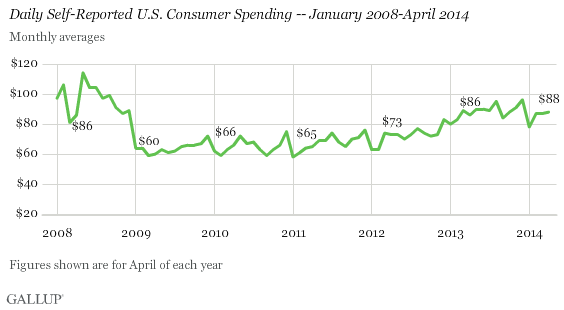WASHINGTON, D.C. -- Americans' reports of daily spending in April averaged $88, virtually the same as in March ($87) and February ($87). This ranks among the best figures for the month of April since Gallup began measuring spending in January 2008, along with April 2008 ($86) and April 2013 ($86).

These figures are based on Americans' self-reports of the total amount they spent "yesterday" in stores, gas stations, restaurants, or online -- not counting home and vehicle purchases, or normal monthly bills.
The April spending estimate can be considered a mixture of positive and negative news for the economy. On the positive side, the $88 average remains on the high end of what Gallup has measured historically, and is clearly above the depressed spending that represented the "new normal" during the recessionary and post-recessionary period of 2009 through 2012. On the negative side, the April estimate is no higher than the estimate from March 2014 or April 2013, suggesting no further growth in spending.
Bottom Line
The lack of growth in consumer spending is a concern for the U.S. economy, especially considering the effect the extreme weather in many parts of the country may have had on spending during the winter months. Perhaps more telling for the economy will be the trajectory of spending in the coming months. May and June spending estimates have usually outpaced April estimates.
Survey Methods
Results for this Gallup poll are based on telephone interviews conducted April 1-30, 2014, on the Gallup Daily tracking survey, with a random sample of 14,703 adults, aged 18 and older, living in all 50 U.S. states and the District of Columbia.
For results based on the total sample of national adults, the margin of sampling error is ±1 percentage point at the 95% confidence level.
Interviews are conducted with respondents on landline telephones and cellular phones, with interviews conducted in Spanish for respondents who are primarily Spanish-speaking. Each sample of national adults includes a minimum quota of 50% cellphone respondents and 50% landline respondents, with additional minimum quotas by time zone within region. Landline and cellular telephone numbers are selected using random-digit-dial methods. Landline respondents are chosen at random within each household on the basis of which member had the most recent birthday.
Samples are weighted to correct for unequal selection probability, nonresponse, and double coverage of landline and cell users in the two sampling frames. They are also weighted to match the national demographics of gender, age, race, Hispanic ethnicity, education, region, population density, and phone status (cellphone only/landline only/both, and cellphone mostly). Demographic weighting targets are based on the most recent Current Population Survey figures for the aged 18 and older U.S. population. Phone status targets are based on the most recent National Health Interview Survey. Population density targets are based on the most recent U.S. census. All reported margins of sampling error include the computed design effects for weighting.
In addition to sampling error, question wording and practical difficulties in conducting surveys can introduce error or bias into the findings of public opinion polls.
For more details on Gallup's polling methodology, visit www.gallup.com.
